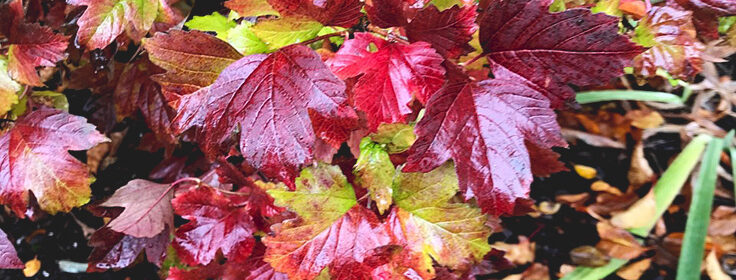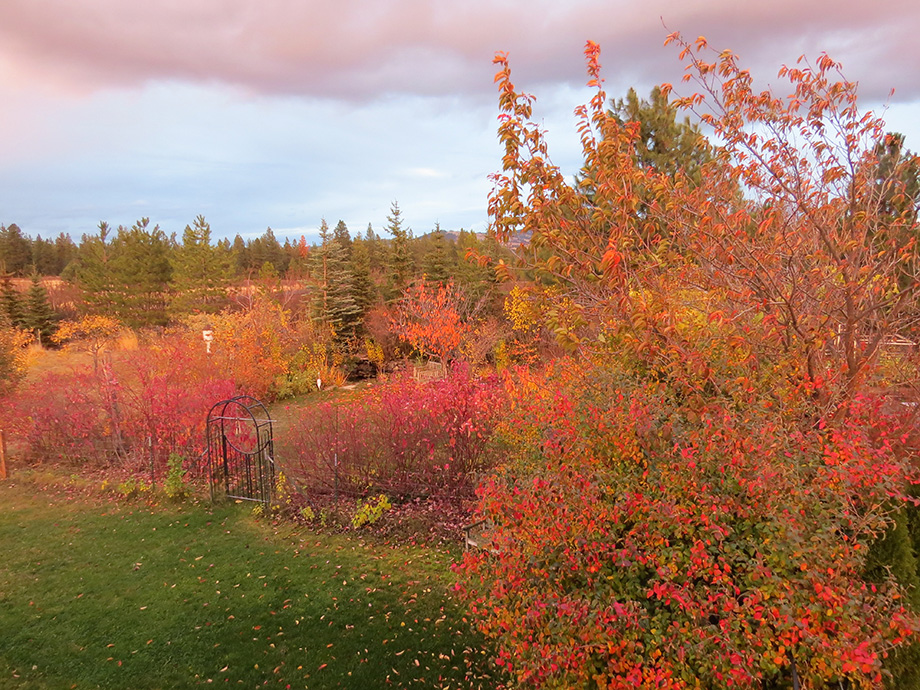Column: Shrubs That Add Fall Color

My garden column today is all about shrubs that will add a lot of color to your landscape during the fall months. That’s a pretty happy topic, right?
As I explain the column, we gardeners can feel discouraged when we realize the growing season is coming to a close. But if you plant shrubs that will treat you to colorful foliage, you’ll have something to look forward to. That’s a great strategy!
If you’re wondering about the photo to the left, that is the view out my office window each fall. Those colorful plants include red Osier dogwood, ‘Kwanzan’ ornamental cherry, Koreanspice viburnums, and vine maples. In the photo at the very top of this post, you can see the striking foliage of a snowball viburnum (V. plicatum).
I hope you’ll enjoy the column and that it will give you some inspiration:
by Susan Mulvihill
If you love fall colors as much as I do, you might want to take a close look at the plants in your landscape over the coming months. While I can’t say it was entirely planned, I’ve somehow managed to plant a lot of shrubs that brighten up our garden right when other plants are winding down for the year.
The American cranberry bush (Viburnum opulus var. americanum) is one of my favorite native shrubs. It has so many great attributes: beautiful lacecap flowers in the spring, glossy green berries during the summer, and vibrant leaves and red berries when fall arrives. As a bonus, the berries attract all sorts of birds during the winter months. The bush will grow 8 to 12 feet in height and is a real stunner. Hardiness zones 2 to 7.
Buttonbush (Cephalanthus occidentalis) is another delightful native shrub that lights up our garden during the fall. Its name refers to the unusual flower clusters that resemble little pincushions and are a big hit with pollinators. The leaves change from green to gold once the temperatures drop. Apparently, they can reach 15 feet in height if you give them a lot of water but ours is a more petite 6 feet. Hardiness zones 4 to 10.
Oakleaf hydrangeas (H. quercifolia) are prized for their distinctive foliage and attractive flowers. When the temperatures start dropping in the fall, these lovely shrubs have one more surprise in store: the leaves change from dark green to burgundy. This hydrangea makes a great accent plant for the landscape and will grow between 4 and 8 feet tall. Hardiness zones 5 to 9.
Red osier dogwood (Cornus sericea) treats gardeners to red stems, white berries that attract birds, and narrow leaves that turn a deep red or orange in the fall. The red stems also provide a lovely contrast with winter snow. This shrub will grow up to 9 feet tall and prefers fairly moist soil. Be aware that they have a tendency to spread. Hardiness zones 2 to 7.
Viburnums make wonderful additions to the landscape. I grow Koreanspice viburnums (V. carlesii) for a few reasons. The white-and-pink-tinged flower clusters are gorgeous and have an intoxicating scent. The slightly glossy, dark-green leaves are attractive. And when fall arrives, the leaves change to red, burgundy and yellow. They typically grow up to 6 feet but mine are overachievers because they’re easily 8 feet tall. Other colorful viburnums include Arrowwood, Brandywine and Burkwood. Hardiness zones 4 to 7.
Spirea is a popular shrub that also will light up your landscape when fall rolls around. Some of the best varieties for our zone include Goldflame, Double Play Candy Corn, Gold Mound, and Magic Carpet. They are really easy to care for and if you deadhead the spent blossoms, they will rebloom for you. Hardiness zones 4 to 8.
Witch hazel is considered either a shrub or small tree. I’m growing the native witch hazel (Hamamelis virginiana), which treats us to golden leaves in October, followed by the coolest-looking blossoms. Because of this, it has been a wonderful addition to our landscape over the years. It can reach a height of 8 to 12 feet. Hardiness zones 3 to 8.
It’s understandable to feel a little down in the dumps when the growing season starts coming to a close. With some wise purchases, fall can become a season to look forward to each year.
Susan Mulvihill is author of “The Vegetable Garden Problem Solver Handbook” and “The Vegetable Garden Pest Handbook.” She can be reached at Susan@SusansintheGarden.com. Watch Susan’s videos at youtube.com/susansinthegarden.

